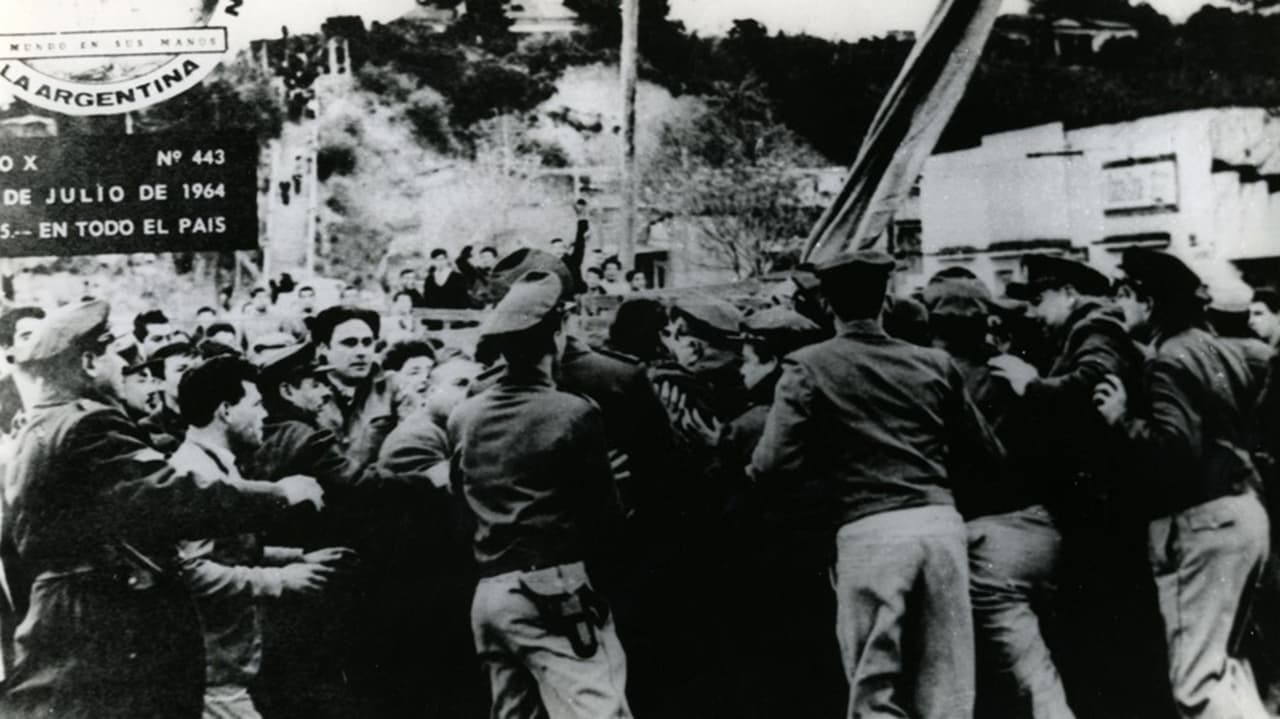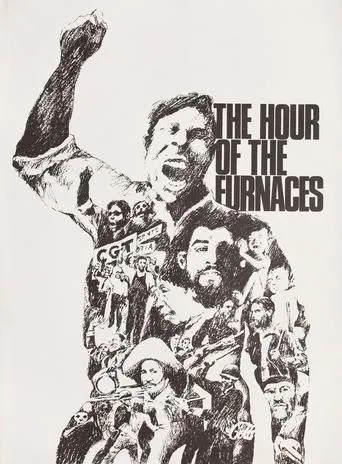

Fernando E. Solanas with Octavio Getino made a documentary about neocolonialism in Latin America. It's a very evocative film, a call to arms. It can be seen as a series of various themes of the revolution. The original version is 4 hours long clearly divided into three independent parts: I Neocolonialism and Violence (95 min), II The Liberation Struggle (120 min), III Violence and Liberation (45 min). But very often in Europe and the States we only see the first part, which might give a little limited picture of the subject - but I can't say for sure because I have only seen the first part in theaters.The first part Neocolonialism and Violence is the second longest and divided into twelve sequences: History, Earth, Everyday violence, Port city - Buenos Aires, Oligarchy, System, Political violence, Neorascism, Dependence, Cultural violence, Ideological war and Alternative option, which ends up filming the face of the dead Che Guevara for 5 minutes.The Hour of the Furnaces was very unique and original but on some level it reminded me of Santiago Alvarez's 79 Springs (1969), which proved that agitation can also be very intellectual. In the same way The Hour of the Furnaces is a synthesis of agitation and poetry. The art of editing and the use of montage is brilliant - the director clearly knows how to use this theory Eisenstein and Vertov created and defined.Through montage Solanas achieved cinema poetry he managed to create mental associations and allegories by showing suffering cows and the imperialistic American mass products. I had already seen impressive films about colonialism and imperialism - to mention a few; Moi un noir (1958) about the imperialism in Ivory Coast by Jean Rouch, The Song of Ceylon (1934) about the colonialism in India by Basil Wright and Les statues meurent aussi (1953) about colonialism in Africa by Chris Marker and Alain Resnais. But none about the neocolonialism in Latin America the intention of The Hour of the Furnaces was clearly to wake up the people from the lethargy they were in. To show the reality and make the revolution happen. Obviously the filmmakers got there. Because I personally didn't know much about this and it was quite shocking to see it - a very eye opening and thought provoking experience.The Hour of the Furnaces is perhaps the greatest and most intelligent agitation can be. It's a realistic description of the neocolonialism in Latin America and about the revolutionaries. It is not just aimed at one group of people, the film manages to speak to all the people. Solanas shows us a society where the price of human life is forgotten, where people do more work and make less money and the world with no human value.
... View MoreArgentinean Fernando Ezequiel Solanas and Spaniard Octavio Getino were two outstanding activists of Latin American cinema. They took different routes (Getino was the philosopher, writing about cinema, economy and politics), but in the 1960s they collaborated on one of the most important manifestos of the "New Latin American cinema", known as "Towards a Third Cinema", and together they made "The Hour of the Furnaces: Notes and Testimonies on Neocolonialism, Violence and Liberation", one of the major works of Latin American documentalism, which they defined as a "cine-act" to inform, beyond the entertainment factor. If one of the three parts that comprise this work has to be seen, "Neocolonialismo y violencia" (running 90 minutes) is the key part and the mandatory section for the specialist to see. This first part is a document with particular annotations, tinted with manichean, dogmatic or contradictory position, inherent to its Peronist proclivity; a document created in a very specific time, when several Latin American countries were living moments of intense political, cultural and social unrest, in their struggles against imperialism. However, it is as striking today as it was in 1968, because of its stylistic devices, recurring to Brecht's alienation effect and the audience's interaction (in some points of parts two and three, intertitles ask to stop the projector and start the debate), but above everything else, because of its lucid approach to neocolonialism in Latin America through a methodical analysis of a particular national history, including the complicity of local oligarchies. This is also the documentary that ends with a long shot of the lifeless face of Ernesto "Che" Guevara filling the screen.
... View MoreFirst of all, I must say I only saw the first part of this film which lasts about 90 minutes. According to the people who were presenting it, the first part is the most accessible to modern, non-Argentine viewers.This film is a lengthy diatribe against the smothering influence of European powers in Argentine cultural and economic life. The anger of the film makers was very effectively expressed by the film's rapid fire pacing, its fiery narration and its harsh, thundering soundtrack. The soundtrack was the strongest element, and its relentless pounding really drove the film maker's points home.This film seemed less like a documentary than a filmed version of a revolutionary pamphlet. The single mindedness of the views expressed and the solution proposed, namely violent revolt, seemed immature and insufficiently reasoned. The views expressed seemed more inspired by bloody minded hatred for outside meddlers than sympathy for the oppressed and marginalized native Argentinians. It was very much a "shoot first and ask questions later" attitude. This is not the sort of attitude that I would want to see shown by my leaders if I were an Argentinian.I suppose much of the bitter hatefulness of this movie can be understood by considering that it is a reaction to very oppressive censorship. Such a movie is acceptable as a preliminary blast against the oppressors, but one would hope that calmer, clearer heads would prevail afterwards. The attitude of the film makers here, in this film, really borders on the unhinged, the demented.
... View MoreAs a very strong document of a lost age it still holds actuality.The film leaves no room for objection and it is assured of it's own truth. The subject of the film is the "Neo-Colonisation" of South America through a historical perspective but is still heavily anchored in the 60s. It is divided into sections labelled The History, The Country, The System and so forth. Each section is usually introduced with a presentation of the subject and it's problems, complications and horrors in a fact like fashion but then drifts into strong pictures illustrating the subject alternatively it uses very strong montage sequences (both audio and visual). Examples of these montages are cuts between ad campaigns and poverty or a slaughterhouse and the exploitation of South American resources and so fort, all skilfully made. In whole the film is a very strong piece of work and it would be futile to, at this level, try and analyse it. Still I would like to comment that it is as much propaganda as manifesto, not that it would make it a worse film but still, it doesn't really strike you as all that very objective. To wrap it up I must say that it is well worth seeing and studying.
... View More